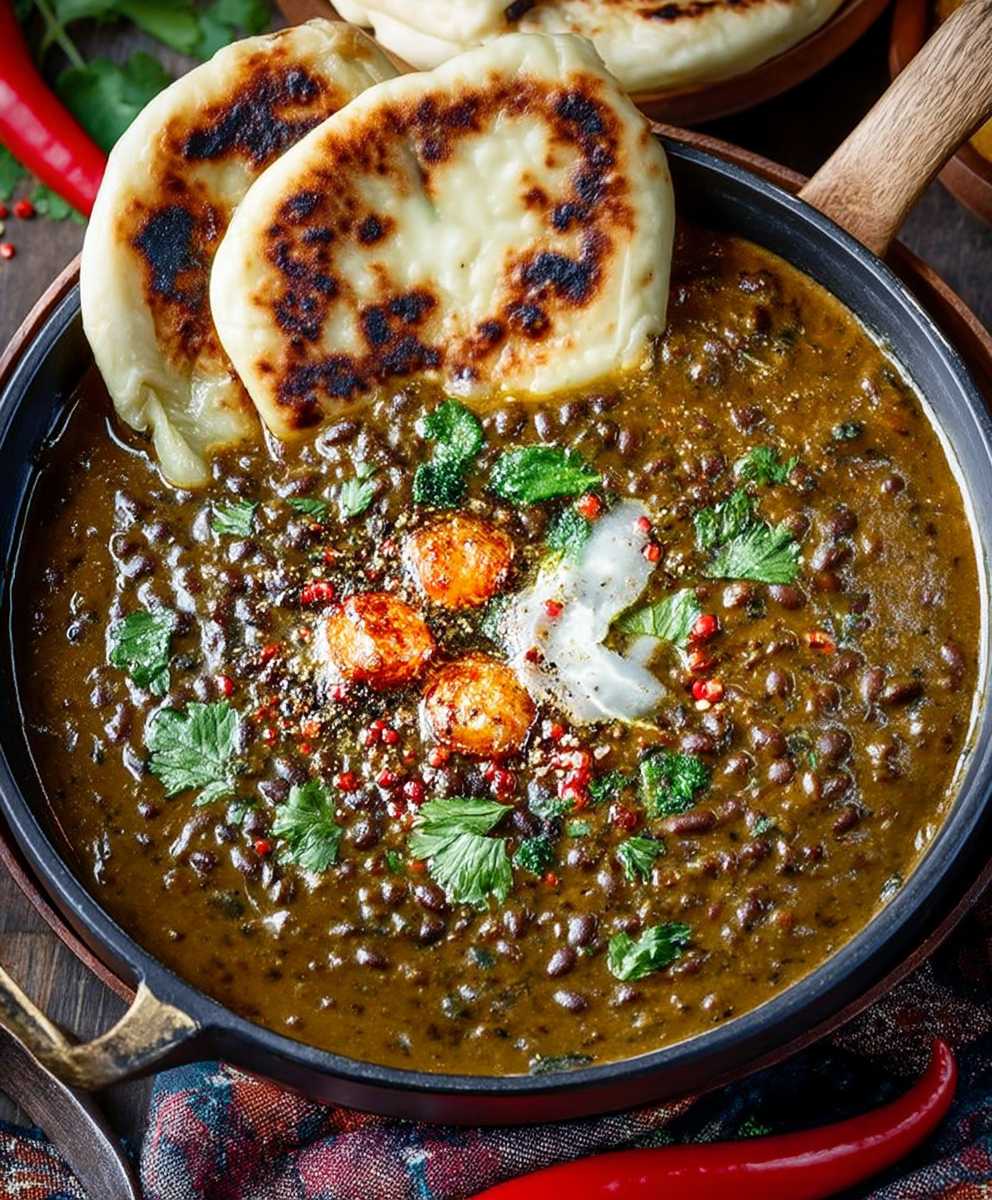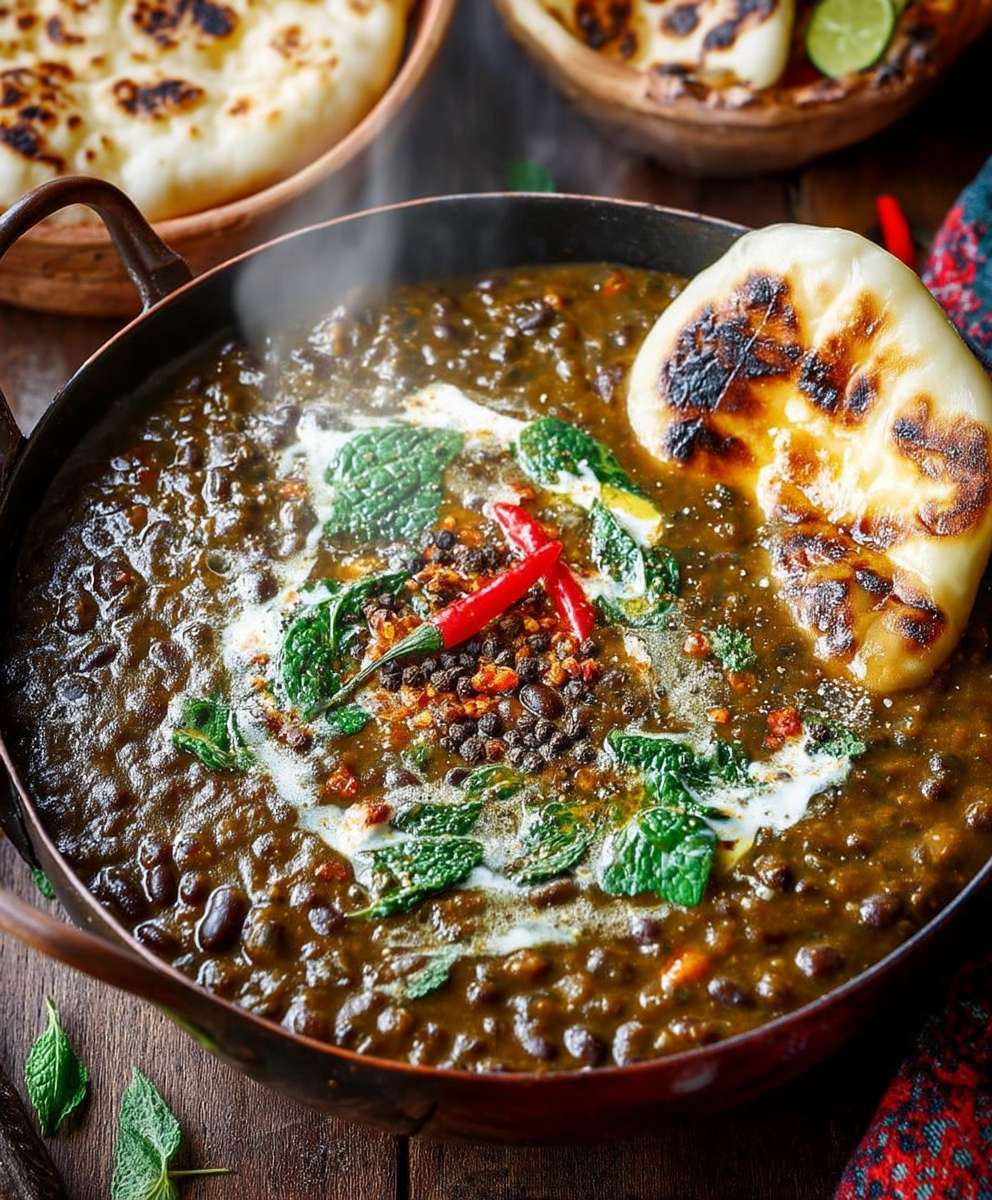Dal Makhani, oh, where do I even begin? This creamy, dreamy lentil dish isn’t just food; it’s an experience, a hug in a bowl, and quite possibly the most comforting thing you’ll ever taste. Have you ever wondered how something so simple could be so incredibly decadent? I certainly have, and after years of perfecting my own version, I’m thrilled to share it with you!
Originating from the Punjab region of India, Dal Makhani, which translates to “buttery lentils,” has a rich history. It’s said to have been invented in the early 20th century by Kundan Lal Jaggi, the founder of the legendary Moti Mahal restaurant in Delhi. He sought to create a dish that was both hearty and luxurious, and boy, did he succeed! The slow cooking process, often simmering overnight, allows the flavors to meld together beautifully, creating a depth of taste that’s simply unparalleled.
What is it about this dish that makes it so universally loved? Well, for starters, the texture is divine. The creamy lentils, combined with the richness of butter and cream, create a velvety smooth sensation that’s incredibly satisfying. The smoky flavor, often achieved through the use of ginger, garlic, and garam masala, adds another layer of complexity. But beyond the taste and texture, Dal Makhani is also incredibly versatile. It’s perfect for a special occasion, a cozy weeknight dinner, or even a potluck with friends. It pairs beautifully with naan bread, rice, or even just enjoyed on its own. So, are you ready to embark on a culinary adventure and create your own pot of this magical dish? Let’s get cooking!
Ingredients:
- 1 cup whole black lentils (urad dal)
- 1/4 cup kidney beans (rajma)
- 4 cups water
- 1 teaspoon salt, or to taste
- 2 tablespoons butter, divided
- 1 medium onion, finely chopped
- 1 tablespoon ginger-garlic paste
- 1 teaspoon red chili powder
- 1/2 teaspoon turmeric powder
- 1/2 teaspoon garam masala
- 1/4 teaspoon dried fenugreek leaves (kasuri methi), crushed
- 1 cup tomato puree
- 1/2 cup heavy cream
- 2 tablespoons chopped fresh cilantro, for garnish
Preparing the Lentils and Beans:
- First things first, we need to soak the lentils and kidney beans. This is crucial for softening them and reducing cooking time. In a large bowl, combine the urad dal and rajma.
- Rinse them thoroughly under cold running water until the water runs clear. This helps remove any impurities.
- Now, add 4 cups of fresh water to the bowl. Make sure the lentils and beans are fully submerged.
- Let them soak for at least 6-8 hours, or preferably overnight. The longer they soak, the better the texture will be. I usually soak them before I go to bed and then cook them the next day.
- After soaking, drain the lentils and beans completely. Discard the soaking water.
Cooking the Lentils and Beans:
- Transfer the soaked and drained lentils and beans to a pressure cooker. If you don’t have a pressure cooker, you can use a large pot, but it will take significantly longer to cook.
- Add 4 cups of fresh water to the pressure cooker.
- Add 1 teaspoon of salt, or adjust to your taste. Remember, you can always add more salt later, but you can’t take it away!
- Close the pressure cooker lid securely and cook on medium-high heat.
- Once the pressure cooker reaches full pressure (you’ll hear the whistle), reduce the heat to low and cook for 45-50 minutes. If you’re using a pot, simmer on low heat for 2-3 hours, or until the lentils and beans are very soft and mushy. Stir occasionally to prevent sticking.
- After the cooking time, turn off the heat and let the pressure release naturally. Do not force the pressure release, as this can be dangerous.
- Once the pressure is completely released, open the pressure cooker lid carefully.
- Check the lentils and beans. They should be very soft and easily mashed with a spoon. If they are still firm, cook them for a little longer.
- Using a ladle or a potato masher, gently mash some of the lentils and beans. This will help create a creamy texture. Don’t mash them completely; you want to retain some whole lentils and beans for texture.
Preparing the Tadka (Tempering):
- Now, let’s prepare the tadka, which is the flavorful tempering that adds depth to the Dal Makhani. Heat 1 tablespoon of butter in a large, heavy-bottomed pot or Dutch oven over medium heat.
- Once the butter is melted, add the finely chopped onion.
- Sauté the onion until it turns golden brown. This usually takes about 5-7 minutes. Make sure to stir frequently to prevent burning. The onions should be nicely caramelized for the best flavor.
- Add the ginger-garlic paste and sauté for another minute, until fragrant. Be careful not to burn the ginger-garlic paste, as it can become bitter.
- Add the red chili powder, turmeric powder, and garam masala. Sauté for 30 seconds, stirring constantly. This will release the flavors of the spices.
- Pour in the tomato puree and cook for 5-7 minutes, or until the tomato puree thickens and the raw smell disappears. Stir occasionally to prevent sticking.
Combining and Simmering:
- Pour the cooked lentils and beans into the pot with the tomato-onion mixture.
- Stir well to combine everything thoroughly.
- Add the crushed dried fenugreek leaves (kasuri methi). This adds a unique aroma and flavor to the Dal Makhani.
- Bring the mixture to a simmer over low heat.
- Cover the pot and simmer for at least 30 minutes, or up to 1-2 hours. The longer it simmers, the richer and more flavorful it will become. Stir occasionally to prevent sticking.
- During the simmering process, you can add more water if the Dal Makhani becomes too thick. The consistency should be creamy and slightly thick.
- After simmering for the desired time, stir in the remaining 1 tablespoon of butter.
- Finally, add the heavy cream and stir gently to combine. Do not boil the Dal Makhani after adding the cream, as it can curdle.
- Taste and adjust the seasoning if needed. You may want to add more salt, red chili powder, or garam masala to your liking.
Serving:
- Ladle the Dal Makhani into serving bowls.
- Garnish with chopped fresh cilantro.
- Serve hot with naan, roti, rice, or any other Indian bread of your choice.
- A dollop of butter or cream on top is also a delicious addition!
Tips for the Best Dal Makhani:
- Soaking is Key: Don’t skip the soaking step! It’s essential for softening the lentils and beans and reducing cooking time.
- Slow Simmering: The longer you simmer the Dal Makhani, the better the flavor will be. Be patient and let it simmer for at least 30 minutes, or even longer if you have the time.
- Fresh Ingredients: Use fresh, high-quality ingredients for the best flavor.
- Adjust to Your Taste: Feel free to adjust the spices and seasonings to your liking. If you prefer a spicier Dal Makhani, add more red chili powder. If you prefer a milder flavor, reduce the amount of red chili powder.
- Creamy Texture: The key to a good Dal Makhani is its creamy texture. Mash some of the lentils and beans during the cooking process to achieve this.
- Garnish Generously: Don’t be shy with the garnish! Fresh cilantro adds a burst of freshness and flavor to the Dal Makhani.
Variations:
- Vegan Dal Makhani: To make this recipe vegan, substitute the butter with vegan butter or oil and the heavy cream with coconut cream or cashew cream.
- Instant Pot Dal Makhani: You can also make Dal Makhani in an Instant Pot. Follow the same steps, but reduce the cooking time to 25-30 minutes on high pressure.
- Smoked Dal Makhani: For a smoky flavor, you can give the Dal Makhani a charcoal smoke infusion. Place a small steel bowl in the center of the pot, add a piece of hot charcoal, pour a teaspoon of ghee over the charcoal, and cover the pot tightly for a few minutes.
Enjoy your homemade Dal Makhani! I hope you find this recipe helpful and that it brings you as much joy as it brings me. Guten Appetit!

Fazit:
Ich hoffe, ich konnte euch mit diesem Rezept für Dal Makhani ein wenig von meiner Begeisterung für die indische Küche vermitteln. Es ist wirklich ein Gericht, das man einfach probiert haben muss! Die cremige Textur, die rauchigen Aromen und die perfekt abgestimmte Gewürzmischung machen es zu einem unvergesslichen Geschmackserlebnis. Und das Beste daran? Es ist gar nicht so schwer zuzubereiten, wie man vielleicht denkt.
Dieses Dal Makhani ist mehr als nur ein Gericht; es ist eine kulinarische Reise. Die Kombination aus schwarzen Linsen und roten Kidneybohnen, langsam gekocht in einer reichhaltigen Sauce aus Butter, Sahne und Gewürzen, ergibt eine Tiefe und Komplexität, die einfach umwerfend ist. Es ist ein Gericht, das wärmt, tröstet und gleichzeitig unglaublich befriedigend ist. Ich verspreche euch, wenn ihr dieses Rezept ausprobiert, werdet ihr es immer wieder kochen wollen!
Aber das ist noch nicht alles! Die Vielseitigkeit dieses Gerichts ist ein weiterer Grund, warum es ein absolutes Muss ist. Ihr könnt es klassisch mit Naan-Brot oder Reis servieren, um die Sauce perfekt aufzusaugen. Oder wie wäre es mit einem Klecks Joghurt und frischem Koriander als Topping? Das bringt eine zusätzliche Frische und Säure ins Spiel, die wunderbar mit den reichhaltigen Aromen harmoniert.
Für eine vegetarische Variante könnt ihr die Butter durch Ghee (geklärte Butter) ersetzen, um den authentischen Geschmack beizubehalten. Und wenn ihr es etwas schärfer mögt, könnt ihr einfach eine Prise mehr Chili hinzufügen. Oder wie wäre es mit einer Prise Garam Masala kurz vor dem Servieren, um das Aroma noch zu intensivieren? Die Möglichkeiten sind endlos!
Hier sind noch ein paar Ideen, wie ihr euer Dal Makhani perfekt in Szene setzen könnt:
- Serviert es mit einem frischen Salat, um einen Kontrast zu den reichhaltigen Aromen zu schaffen.
- Verwendet es als Füllung für Samosas oder als Dip für Papadums.
- Kombiniert es mit anderen indischen Gerichten wie Butter Chicken oder Palak Paneer für ein komplettes Menü.
- Bereitet eine größere Menge zu und friert sie ein, um jederzeit ein schnelles und leckeres Essen zur Hand zu haben.
Ich bin wirklich gespannt, wie euch mein Rezept gefällt! Probiert es unbedingt aus und lasst mich wissen, was ihr davon haltet. Teilt eure Erfahrungen, eure Variationen und eure Fotos mit mir! Ich freue mich darauf, von euch zu hören und zu sehen, wie ihr euer eigenes, einzigartiges Dal Makhani kreiert. Vergesst nicht, den Hashtag #DalMakhaniLiebe zu verwenden, damit ich eure Kreationen auch finde!
Also, worauf wartet ihr noch? Ran an die Töpfe und lasst uns gemeinsam dieses köstliche Gericht zubereiten! Ich bin sicher, ihr werdet es lieben!
Guten Appetit!
Ein reichhaltiges und cremiges indisches Linsengericht, das langsam gekocht wird, um einen tiefen, komplexen Geschmack zu entwickeln. Dal Makhani ist perfekt für einen gemütlichen Abend oder ein besonderes Essen.
Ingredients
Instructions
Linsen und Bohnen vorbereiten: Urad Dal und Rajma in einer großen Schüssel kombinieren. Unter kaltem Wasser abspülen, bis das Wasser klar ist. 4 Tassen frisches Wasser hinzufügen und mindestens 6-8 Stunden oder über Nacht einweichen lassen. Nach dem Einweichen abgießen und das Einweichwasser verwerfen.
Linsen und Bohnen kochen: Die eingeweichten Linsen und Bohnen in einen Schnellkochtopf geben. 4 Tassen frisches Wasser und 1 Teelöffel Salz hinzufügen. Den Schnellkochtopf verschließen und bei mittlerer bis hoher Hitze kochen. Sobald der Schnellkochtopf vollen Druck erreicht hat, die Hitze reduzieren und 45-50 Minuten kochen lassen. Wenn Sie einen Topf verwenden, bei schwacher Hitze 2-3 Stunden köcheln lassen, oder bis die Linsen und Bohnen sehr weich sind. Gelegentlich umrühren, um ein Anhaften zu verhindern. Nach der Garzeit die Hitze abstellen und den Druck auf natürliche Weise ablassen. Den Deckel des Schnellkochtopfs vorsichtig öffnen. Die Linsen und Bohnen sollten sehr weich sein und sich leicht mit einem Löffel zerdrücken lassen. Mit einem Löffel oder Kartoffelstampfer einen Teil der Linsen und Bohnen leicht zerdrücken.
Tadka (Würzmischung) zubereiten: 1 Esslöffel Butter in einem großen, schweren Topf oder Schmortopf bei mittlerer Hitze schmelzen. Die fein gehackte Zwiebel hinzufügen und goldbraun anbraten. Die Ingwer-Knoblauch-Paste hinzufügen und eine weitere Minute anbraten, bis sie duftet. Das rote Chilipulver, Kurkumapulver und Garam Masala hinzufügen. 30 Sekunden unter ständigem Rühren anbraten. Die passierten Tomaten dazugeben und 5-7 Minuten kochen lassen, oder bis die passierten Tomaten eindicken und der rohe Geruch verschwindet.
Kombinieren und Köcheln lassen: Die gekochten Linsen und Bohnen in den Topf mit der Tomaten-Zwiebel-Mischung geben. Gut umrühren, um alles gründlich zu vermischen. Die zerdrückten getrockneten Bockshornkleeblätter (Kasuri Methi) hinzufügen. Die Mischung bei schwacher Hitze zum Köcheln bringen. Den Topf abdecken und mindestens 30 Minuten oder bis zu 1-2 Stunden köcheln lassen. Gelegentlich umrühren, um ein Anhaften zu verhindern. Während des Köchelns mehr Wasser hinzufügen, wenn das Dal Makhani zu dick wird. Nach dem Köcheln den restlichen 1 Esslöffel Butter einrühren. Zum Schluss die Schlagsahne hinzufügen und vorsichtig verrühren. Das Dal Makhani nach dem Hinzufügen der Sahne nicht mehr kochen lassen. Abschmecken und gegebenenfalls nachwürzen.
Servieren: Das Dal Makhani in Schüsseln füllen. Mit gehacktem frischen Koriander garnieren. Heiß mit Naan, Roti, Reis oder anderem indischen Brot Ihrer Wahl servieren.
Notes
- Einweichen ist wichtig: Das Einweichen der Linsen und Bohnen ist entscheidend, um sie weicher zu machen und die Kochzeit zu verkürzen.
- Langsames Köcheln: Je länger Sie das Dal Makhani köcheln lassen, desto besser wird der Geschmack.
- Frische Zutaten: Verwenden Sie frische, hochwertige Zutaten für den besten Geschmack.
- An Ihren Geschmack anpassen: Passen Sie die Gewürze und Aromen nach Ihren Wünschen an.
- Cremige Textur: Das Zerdrücken eines Teils der Linsen und Bohnen während des Kochens trägt zu einer cremigen Textur bei.
- Großzügig garnieren: Frischer Koriander verleiht dem Dal Makhani einen Hauch von Frische und Geschmack.
- Vegane Variante: Ersetzen Sie die Butter durch vegane Butter oder Öl und die Schlagsahne durch Kokosnusscreme oder Cashewcreme.
- Instant Pot Dal Makhani: Sie können Dal Makhani auch im Instant Pot zubereiten. Befolgen Sie die gleichen Schritte, reduzieren Sie jedoch die Garzeit auf 25-30 Minuten bei hohem Druck.
- Geräuchertes Dal Makhani: Für einen rauchigen Geschmack können Sie dem Dal Makhani eine Holzkohle-Rauchinfusion geben. Stellen Sie eine kleine Stahlschüssel in die Mitte des Topfes, fügen Sie ein Stück heiße Holzkohle hinzu, gießen Sie einen Teelöffel Ghee über die Holzkohle und decken Sie den Topf einige Minuten lang fest ab.






Leave a Comment